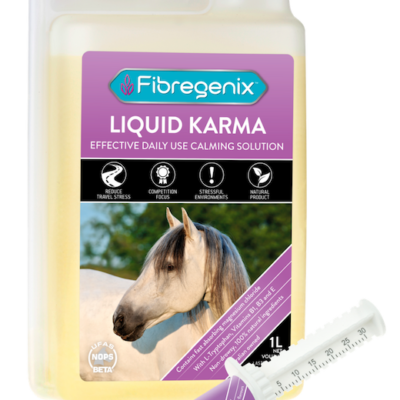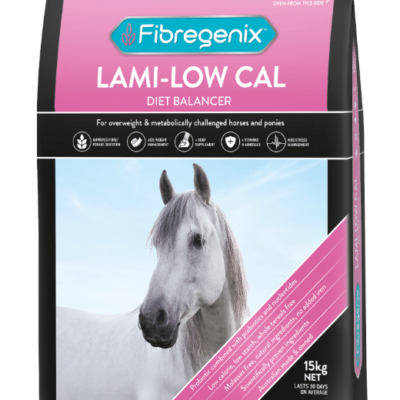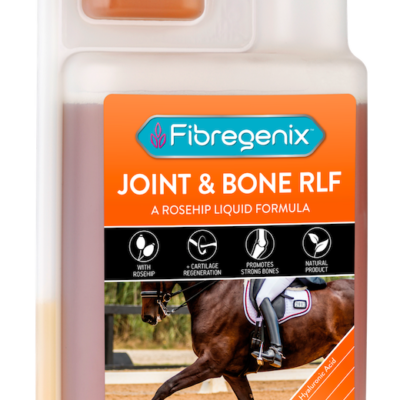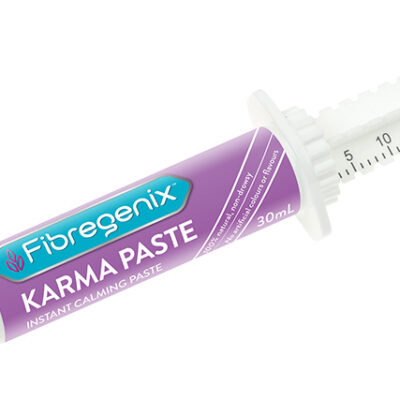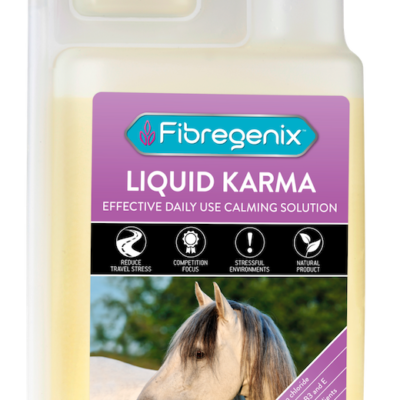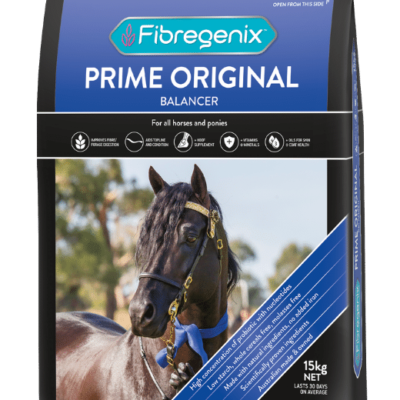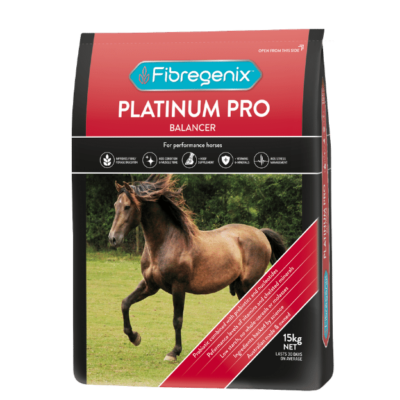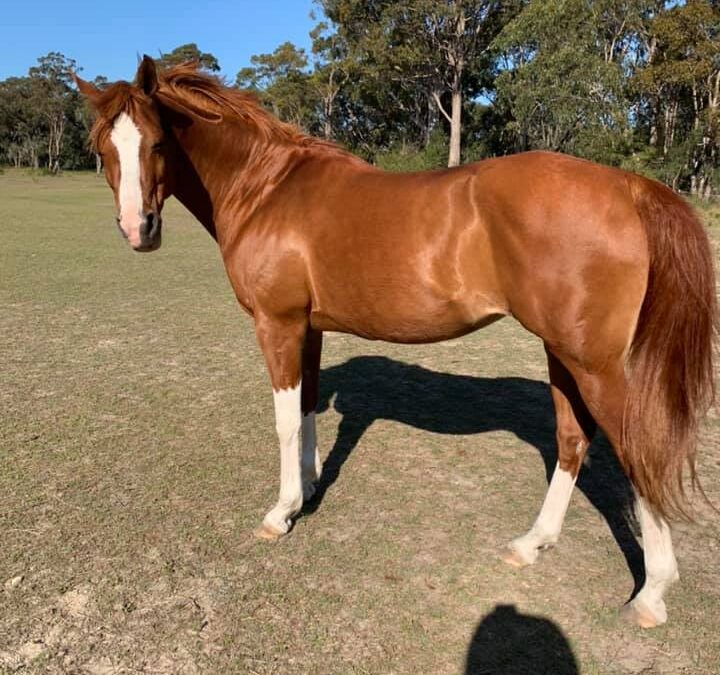
Aug 16, 2021 | General feeding practices
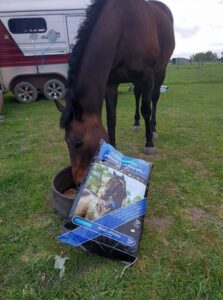
Bucks tucking into his Fibregenix
Here’s our ultimate guide to effective, simple feeding with balancers. So, you’ve taken the plunge and got your first bag of Fibregenix. A good decision made! Fibregenix feed balancers will be you and your horse’s best friends. Bucks certainly thinks so!
The 3 big questions we are most often asked.
1. How do I keep an effective, simple feeding regime with Fibregenix feed balancers?
Well, as you know, we are big promoters of fibre feeding in the first instance. It’s what is naturally best for your horse or pony, and what he/she has evolved to eat. So, it’s a no-brainer to keep your horse or pony’s diet mostly forage based. However, we do appreciate that there are times when your horse may require more calories (energy). Furthermore, not all horses are good doers. More on that later…
2. What other feeds do I feed with it?
Here are some suggestions to accompany your balancer (which is fed at 100g per 100kg of bodyweight). (Remember, to avoid dietary imbalances and potential nutrient conflicts, you generally shouldn’t need to feed additional supplements).
Fibregenix Prime Original for horses up to novice level, show horses & ponies, broodmares & foals:
Suggested Fibre feeds: Hay (cereal, meadow, legume), haylage, hay cubes, Lucerne chaff/pellets, cereal chaffs, shandy chaffs, beet pulp products. There are plenty to choose from but avoid heavily molassed products.
Fibregenix Platinum Pro for performance horses in hard work, veterans or those with compromised digestive systems.
Feed any of the fibre feeds as above and if feeding for slow-release energy eg endurance – oils/fats NB: Cold pressed linseed oil has the best balance of OM3:OM6)
Feeding for fast-release energy eg, eventing, racing, polo etc
Straight Grains: oats, (whole, crushed or naked); barley, (boiled or micronized); maize – (flaked/ micronized). Legumes eg lupins. Oil can also replace part of your grain ration. We suggest linseed oil or simple veggie oil. Standard hard feeds can also be partially replaced with any of the balancers. Be aware of the starch content of grains or standard hard feeds. Always feed in several small meals to avoid compromising the digestive system.
Healthy Horse Tip: A horse’s stomach can only hold approx. 0.5% of its bodyweight in feed at one time. Eg a 500kg horse’s stomach can only hold 2.5kg of feed. This includes not just hard feed, but chaff and any other additional feedstuffs eg beet pulp. So always keep within this parameter and split feeds into smaller meals. Yes, tedious I know but it’s all for the greater good! …
Fibregenix Lami Low-Cal – for laminitis prone horses and ponies and other metabolic issues, good doers, stable confinement.
Soaked hay, low NSC hay (preferably below 10%), low sugar chaff, unmolassed beet pulp. Restrict grazing or yard with appropriate amounts of soaked hay fed in a slow feeder net. (Never starve an overweight or laminitic horse or pony)
3. Do I still need to feed hard feed?
This totally depends on the type of work your horse/pony is doing. You also need to consider his breed type/temperament, or if he has any health issues. Always feed for the work being done, not what you think your horse is going to do. This means if you aren’t working your horse, back off the hard feeds! Generally, horses and ponies can be split into 3 types – good doers, normal doers and poor doers.
Good doers eg native ponies, cobs or horses with a naturally laid-back temperament. Fibre feeds alongside Lami Low-Cal balancer will suit these types best. Even in light to moderate work. And if in hard work, low energy feeds such as beet pulp or small amounts of legumes such as lupins or good quality forage will provide extra energy.
Normal doers are just that. They are easy to keep weight on but don’t get overly heavy or drop weight when the wind changes direction. Keep the diet high in fibre and monitor weight as you go along. Add legumes such as lupins and oil for grain free energy sources.
Poor Doers. This category of horse or pony often has a history of digestive issue – predominantly ulcers. (Stomach or Hindgut). They could also have a history of a heavy worm burden which can affect gut motility and create a horse which will be a poor doer all its life. They may be super sensitive types and have a hot temperament which can be genetic or due to the aforementioned gut issues eg TBs or Warmbloods. So, what do you feed a poor doer when high energy feeds are needed for work but must be limited or are totally off limits? Grain free energy sources eg lupins, beet pulp and oil/fat. We have customers with starred TB event horses that cannot tolerate grains. These horses do very well on a basic diet fed in appropriate amounts of course.
Meeting his daily feed requirements.
Bear in mind that your horse needs at least 2% of his bodyweight in total dry matter feed intake every day. If he drops off, firstly check the quality of your forage and how much you’re actually feeding.
Secondly, remember the Horse Health Tip of small regular feeds, rather than overburdening the digestive system. If you’re feeding heaps of feed and he isn’t gaining or is still dropping weight, consult with your vet. He may need scoping for ulcers, and they must be treated to heal and clear. Alternatively, there could be other digestive or health issues, so get him checked out.
Take Home message: Maintain a simple feed regime to keep your horse’s digestive system happy. Contact us if you need help with your horse’s diet. We’re always happy to advise and have a wealth of experience of feeding all types of horses and ponies whatever their workload/circumstances.
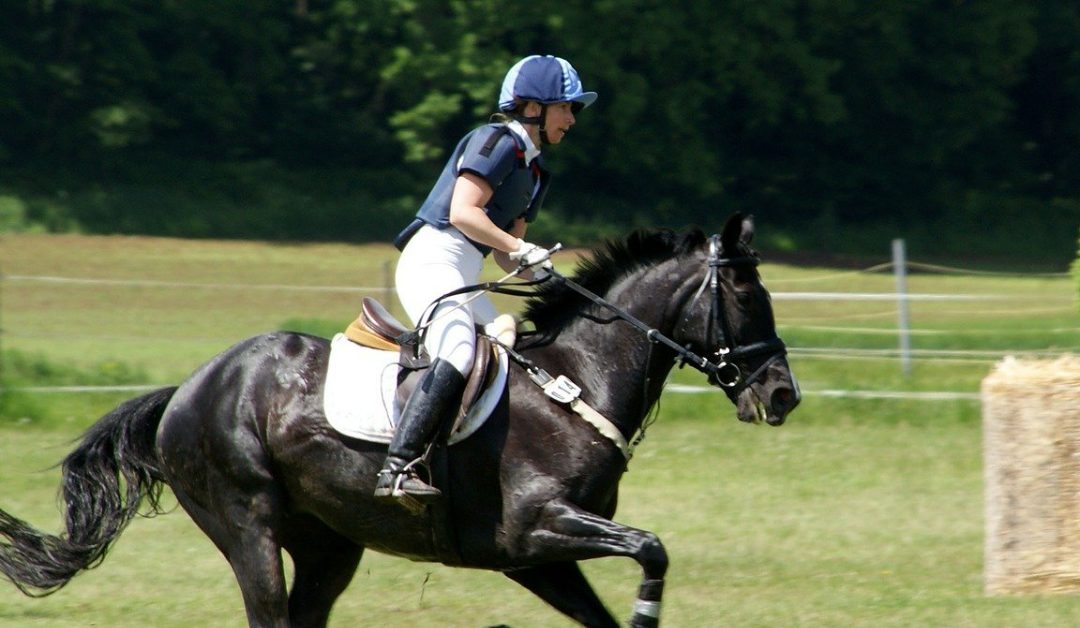
Sep 29, 2020 | Horse health
RER, PSSM, Azoturia, Monday Morning disease, Set-fast…
So what exactly is tying up in horses? These muscle problems have previously had a variety of different names which have described the symptoms rather than the disease. However, advances in research have resulted in a better understanding of the disorders and more appropriate names have been introduced. Two distinct disease processes have been identified. Each one seeming to be prevalent in certain breeds, suggesting that a genetic factor is likely to be involved. Furthermore, it might be worth checking what you’re feeding…
Trigger Factors for Tying Up in Horses
One of the questions that frustrates owners of horses that suffer with tying up is why does it happen one day and not the next? Often, there’s no obvious reason why the problem occurred on any given day. However in some cases it can be that a number of trigger factors all coincided sufficiently to tip the balance. Possible trigger factors include
- not reducing the feed prior to a day off,
- not warming-up or cooling down properly,
- high starch diets,
- dehydration/fatigue
- viral infections.
On their own, the horse can often tolerate one or other of these factors but when several combine, problems can occur.
Symptoms of Tying Up in Horses
The degree of severity of the symptoms of tying up in horses can vary enormously. A horse may appear slightly stiff but is still able to work to some degree. Alternatively, it could be a complete seizing of the muscles so that the horse can’t move. If the symptoms are only very slight then it’s very difficult to diagnose the problem as there could be several other causes. When seeking advice from a vet or nutritionist it’s very important you give details of when the problem occurred. For example, was it before, during or after the horse had worked? You will also need to provide details about the horse’s regime that day to enable them to advise you on a suitable diet.
DIET SUGGESTIONS FOR TYING UP IN HORSES
POLYSACCHARIDE STORAGE MYOPATHY (PSSM)
- Quarter horses, Warmbloods and draught horses are most commonly affected
- Typically, quiet laid back animals but with no gender bias
- Prevents normal metabolism of glycogen which is how the horse stores starch and sugars in his muscles
PSSM
- Eliminate cereal grains and molasses from the diet
- Use oil and fibre as energy sources according to the horse’s bodyweight and workload
- Provide a balance of vitamins, minerals and protein
How to achieve this:
Step 1 – Feed plenty of forage – Forage should form the basis of all horse’s diets but is particularly important in horses that can’t tolerate large amounts of grain. Select as good a forage as possible as this will provide more energy and nutrients which will help to meet the horses overall requirements.
Step 2 – Select a balancer – Fibregenix Lami Low-Cal for horses in light to moderate work or Fibregenix Platinum Pro for horses and ponies in moderate to hard work. These will provide the nutrients required to maintain health and condition and for work.
Step 3 – Add oil or highly digestible fibre – A high oil supplement can be fed alongside a balancer and provides a concentrated source of slow-release calories. Sources of highly digestible fibre, eg beet pulp, are also useful.
(RECURRENT) EXERTIONAL RHABDOMYOLYSIS (RER/ERS)
- Thoroughbreds and Standardbreds most commonly affected
- Excitable, highly-strung increases risk, with fillies more prone
- A stress-related disorder involving disruption of normal muscle calcium regulation
RER/ERS
- Reduce the starch content of the diet
- Ensure that any cereals in the diet have been cooked
- Ensure the diet is balanced
How to achieve this:
Step 1 – Choose a feed with as low a starch content as possible – Feeds which contain high levels of digestible fibre and oil, as energy sources. These will be lower in starch than those which are primarily cereal-based. Generally, pellets/cubes will also have a lower starch content than a mix with an equivalent Digestible Energy content.
Step 2 – Check that the feed used is appropriate for the type and level of work the horse is doing and fed at recommended levels to ensure a fully balanced diet – Feeds are formulated to be fed at certain levels. However, using the wrong one or feeding less than recommended can mean that the horse isn’t receiving sufficient nutrients. Unfortunately, increasing the feed can result in over-exuberant behaviour or weight gain. Therefore a good alternative is to add a Fibregenix balancer to provide nutrients without energy.
Step 3 – Add an electrolyte supplement – ERS is most common in horses in hard, fast work and so an electrolyte supplement is vital to replace salts lost in sweat.
Management Tips for Tying Up in Horses
- Warm up and cool down the horse thoroughly
- Do not confine the horse to the stable for long periods
- An episode of ERS often seems to occur after the horse has suffered with a virus. If you suspect your horse has a virus then reduce the workload, particularly if the horse has had RER/ERS before.
Electrolytes
Electrolytes are minerals that, when in solution, dissociate and have electrical charges. The concentrations of electrolytes affect the movement of body fluids between cells. Most of the sodium, chloride and much of the water, lost in sweat comes from the extracellular fluid. This fluid consists of the plasma portion of blood and the interstitial fluid which surrounds the cells in the body. Most of the potassium and some of the water comes from the intracellular fluid (water inside the cells).
The most effective way to re-hydrate a horse is to supply water and electrolytes. This is more effective than either on their own. Ideally, electrolytes should therefore be added to the water. However, if this puts the horse off drinking, add them to the feed but make it wet and slushy.
Take home message:
Follow appropriate management procedures and nutrition for tying up in horses. This will help reduce the likelihood or frequency of episodes even for those with an underlying genetic susceptibility.
Reviewed and republished April 2021

Apr 29, 2020 | Feeding for different activities
Feeding for energy can be a confusing prospect. Providing your horse with the ideal balance of energy for his needs requires some consideration of both diet AND workload.
In this blog, we take a closer look at the main energy-providing nutrients. We look at how to decide what your horse needs and provide energy to young horses for sparkle without fizz.
It seems that energy itself, even though it’s a relatively simple concept, can be quite hard to grasp. So first of all, what do we really mean by energy?
Fact – Energy cannot be created or destroyed
Yep, you read correctly. Energy is simply converted from one form to another. The easiest way to think about its origin is that it’s released from another nutrient upon its breakdown. The main energy source nutrients within your horse’s diet are proteins, carbohydrates and fats and oils. Each differs in their energy content.
Feeding your horse for energy – Where does energy come from?
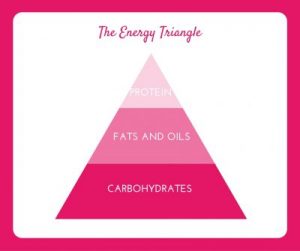
Proteins – Proteins are primarily used by the horse for muscle growth and development. Proteins are actually inefficient and furthermore an expensive source of energy. Protein as energy is only used when carbohydrates and fats are not available or in short supply.
Fats and Oils – Both are energy-dense containing 2.25 times the amount of energy that’s stored in the same mass of carbohydrates. What separates them, however, is the type of fatty acids they contain. The healthier and better quality oils come from expensive crops such as linseed (flaxeed) and contain a higher rate of anti-inflammatory Omega 3 fatty acid than Omega 6. By comparison, the more common and cheaper fat products eg rice bran or canola, provide higher levels of pro-inflammatory Omega 6 than Omega 3. Any feeds high in fats are very conditioning and should, therefore, be fed with caution.
Carbohydrates – Carbohydrates come in several forms and are the main energy source in the equine diet. Simple sugars, such as glucose, are water-soluble forms of carbohydrates found in cereal grains. These provide a quick-release source of energy. Complex carbohydrates, eg those found in fibre, make up the greater proportion of the diet. Fibre contains structural polysaccharides such as cellulose and hemicellulose. Due to their properties and method of breakdown, they release energy over a longer period. This makes fibre an excellent source of slow-release energy.
Feeding your horse for energy – Weight Gain or Work
Energy for work and energy that causes weight gain is essentially the same. So if your horse gets more energy than he can use through exercise and metabolic processes, he’ll store it as fat. Obviously, this will contribute to weight gain. This fact can be exploited and implemented in a positive way when feeding thin horses that need to gain weight. But it’s also a no-brainer that horses who struggle with being overweight shouldn’t be fed energy to excess.
When considering energy for work, horses that are training harder will, of course, require a higher calorie input. Therefore, they should be fed to accommodate the additional exertion their bodies will undergo during exercise. This diet, however, wouldn’t be suitable for a horse in light work as it could contribute to weight gain. That’s why it’s so important to strike the correct balance between energy provided and energy being utilised by the horse.
What is Digestible Energy?
The Digestible Energy of a feed component is the Gross Energy minus the energy lost in the faeces. It’s not actually a legally recognised measure of energy for horses, so it doesn’t have to be declared on feed bags. Having said that, it’s a really helpful way of indicating the energy content of a given feed. It’s also very useful when calculating overall digestible energy intake and fortunately most feed companies detail it anyway.
The table below shows the DE differences in some common feedstuffs. Digestible Energy is one of the first things you should check to assess its suitability for your horse,
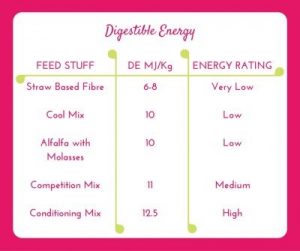 Look at the Digestible Energy (DE) per kg of the fibre. It’s quite low, so it can’t provide too much energy per gram of dry matter. This would correspond with the volume at which you would feed it. After all, fibre should be making up the largest proportion of the diet. However, look at the conditioning mix. Whilst fed in much smaller quantities, it has a much higher DE per kg. Therefore feeding too much of a high DE feed in the incorrect quantity could affect your horse’s weight and condition!
Look at the Digestible Energy (DE) per kg of the fibre. It’s quite low, so it can’t provide too much energy per gram of dry matter. This would correspond with the volume at which you would feed it. After all, fibre should be making up the largest proportion of the diet. However, look at the conditioning mix. Whilst fed in much smaller quantities, it has a much higher DE per kg. Therefore feeding too much of a high DE feed in the incorrect quantity could affect your horse’s weight and condition!
Feeding your horse for Energy – How do we measure it?
Energy is measured in the same way as it is for humans – in Calories (cal) and Joules (J). One Calorie is 4.2 Joules, however, the energy levels of horse feeds are usually measured in Megajoules (Mj), (one million Joules). This may seem like a lot, but horses require a higher level of energy input than humans to sustain vital metabolic processes.
Why does my Horse lack Energy?
Here are 6 reasons why your horse might be lacking in energy.
- You’re not feeding him enough energy
- He has a naturally laid-back temperament
- There’s an electrolyte imbalance
- He may have worms or a reduced digestive function
- He’s had a high starch diet within 4 hours before competing
- Underlying illness
Common Scenario Question 1:
My competition horse needs more energy – can I add some oats before he competes?
Here’s the thing…An abrupt dietary change can a) increase the risk of colic. b) This ‘instant’ energy will disrupt the digestive microbes causing ‘acid’ guts resulting in behavioural issues in some horses. This is the last thing you want before a competition! c) Notwithstanding that, during exercise, horses, like humans, use stored energy sources, not energy directly from their previous meal.
This means he’d need to be consuming oats daily to safely receive the full energy benefits they provide. Not just on or before the competition day. Oats are useful for adding quick-release energy into the diet for horses that are lethargic or lacking energy. But this shouldn’t be seen as a substitute for ensuring adequate fitness.
Another common misconception is that feeding ‘high energy’ feeds can help improve energy levels without causing weight gain. You need to remember that calories are just units of energy, so high energy feeds are also high in calories. Whilst feeds such as competition mixes or straight oats can work to an extent, they’re best used as part of a fully-balanced diet. And in combination with a suitable fitness regime.
Common scenario Question 2:
Your young horse is ridden four to five times a week but you’re finding he lacks energy. Though he’s getting fitter, he lacks that drive you think could be to do with him lacking energy from his feed. So how do you feed him to provide more energy without making him ‘fizzy’? And also, will it promote muscle build-up for his topline?
Finding the right balance of condition and ridden energy can be tricky for horses of any age, particularly youngsters. However, remember the rules of feeding for energy before you go about changing too much.
Basically, energy and calories are the same thing. So you can’t supply energy for ridden work without supplying calories that might fuel weight gain or vice versa. One way of assessing whether your horse is receiving the appropriate level of energy is evaluating his condition.
Body Condition Scoring
The best way of doing this is by body condition scoring. It’ll give you an idea if his diet is providing sufficient energy to cover his energy needs. Remember, body condition scoring only evaluates external fat coverage not muscle development. Bear this in mind, as feeding alone won’t increase muscle tone or topline. This is more influenced by appropriate schooling and making sure the diet has adequate levels of quality protein.
On a scale of 1-9, you’re looking for your horse to be a 5 as this is described as the ‘ideal’. If your horse is carrying too much fat you’ll need to reduce his energy intake. At the same time, you should maintain an adequate supply of vitamins and minerals to keep his diet balanced.
If he’s not carrying enough condition, you’ll need to increase the calories in his diet. This can be achieved by feeding an oil, preferably one high in Omega 3 fatty acids. Alongside this, a quality fibre-based diet will provide non-heating calories. Try and avoid high quantities of cereal-based feeds which can cause digestive issues. If feeding less than the manufacturer’s recommended daily serve, provide a boost of nutrients and protein with an appropriate balancer. The best balancers will contain digestive enhancers to increase fibre digestibility. This, in turn, helps maximise the nutrients and calories he gets out of his diet.
If your young horse is an ideal weight, changing feed is unlikely to be the answer for more ridden energy. It’s his fitness level or ultimately his temperament that’s more likely to influence this. Remember, some breeds are more ‘laid-back’ than others, lacking that natural ‘oomph’, so they’ll often seem to lack energy.
Take-Home Message
Feeding high starch feed to gain instant energy can increase the risk of many digestive or metabolic conditions. Eg gastric ulcers, colic, tying up and laminitis to name a few. In many cases, it won’t provide more ridden energy, and more often than not contributes to excitability or ‘fizzy’ behaviour.
The best strategy is to work on your horse’s fitness levels and provide a balanced diet. Ideally, one which maintains him in an ideal body condition. This will allow your horse to make the most of his diet keeping him in top condition all year round.
Reviewed and amended April 2021
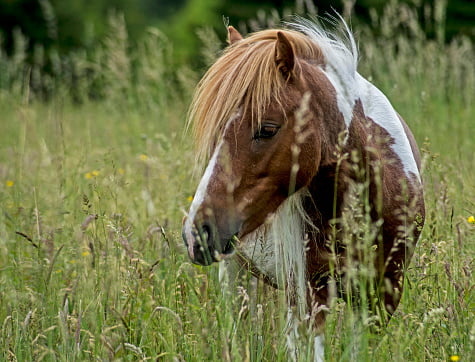
Apr 2, 2020 | General feeding practices
Reduce Feeding Costs
Feeding horses can get really expensive. Are you worried about the cost of your horse’s supplements and hard feeds? Are you looking to reduce feeding costs? How will you do this without it impacting on your horse’s condition, topline or coat and hooves?
Maybe you’ve had to make cutbacks in your horse’s diet due to a reduced workload or to simply save dollars. If you’ve had to opt for a simpler fibre-based diet, what should you feed alongside it? A vitamin/mineral supplement? An additional gut supplement? Extra protein plus something for hooves and coat? All or some of these things?
If you’re currently feeding any of the above supplements, why not consolidate EVERYTHING into just one product? But which product should you choose for the most effectiveness, ease of use, dollar saving, peace of mind and the best results?
To help you choose, we explain the most common types of feed products and what they do for your horse.
Complete feeds, Hard Feeds, Fibregenix balancer supplements – What’s the difference?
Reduce Feeding Costs with a Complete feed – What is it?
A feed that contains everything your horse needs in his diet including the forage.
Benefits:
It can be fed as the sole ration—no need for hay or pasture – just provide water and the complete feed.
High fibre and is ideal for senior horses that can’t chew or fully utilise hay or pasture
Downsides:
Tends to have very large serving sizes, often around 1.5% of the horse’s bodyweight so a bag won’t last very long.
People often provide additional forage/grazing, so your horse can be getting too much for his daily needs.
Adding extra forage or supplementation defies the purpose of a complete feed making it cost-ineffective.
Reduce Feeding Costs with a Hard feed – What is it?
A processed feed that’s generally cereal-based and is fortified with a vitamin and mineral premix. It may or may not also contain some lower quality or least cost digestive aids. It needs to be fed alongside an appropriate amount of forage, (usually recommended as no less than 1% of bodyweight)
Benefits:
It provides energy and calories, plus essential nutrients in one feed. Just add forage and you’re good to go.
Downsides:
Because the concentration of vitamins and minerals per kilogram is quite low, your horse must be fed the recommended daily feed rate. This is to ensure he gets adequate levels of nutrients to balance his diet. It also inevitably means feeding multiple kilos.
The high levels of starch/sugar/energy eaten to satisfy the daily essential nutrient requirements, can often mean horses put on weight. They may become hyperactive/excitable. Worst case scenario, it can cause digestive issues eg stomach ulcers or ‘acid guts’ from over-consumption of starch in any one meal.
Not ideal for grain sensitive or metabolically challenged horses or ponies.
High starch meals will need to be broken down into several smaller meals per day which isn’t time effective for anyone who can only feed twice a day.
A bag won’t last very long if fed at the recommended daily feed rate, so it can be expensive. Eg a feeding rate of 3kg per day for an average 500kg horse means a bag will last just over 6 days.
Reduce Feeding Costs with a Fibregenix Feed Balancer – What is it?
Think of it as an all in one multi-supplement. In essence, a heavily fortified feed product containing some fibre, protein and fatty acids, superior digestive aids and essential nutrients. It’s designed to be fed alongside forage and complements common forages’ nutrient profiles. A Fibregenix feed balancer may seem more expensive than other feed products, but being concentrated, only a small amount is fed. So a bag of balancer will actually last longer than a bag of hard feed This makes it versatile and far more cost-effective long term.
Benefits:
- Gives your horse a healthier digestive system thanks to specific digestive supplements. These can help process fibre more efficiently, maximising nutrient yield and helping to reduce the risk of digestive upsets
- Keeps your horse in great condition
- Maintains that precious topline you’ve worked so hard to build
- Promotes the shiniest and glossiest coat
- Promotes healthy hooves
- Provides all the essential nutrients needed on a daily basis in the most absorbable form. We’ve made no compromise in the selection of the ingredients for Fibregenix feed balancers. Only the best has been selected irrespective of the premium price some of them carry.
- Low feeding rate, palatable and can be fed by hand at the paddock gate or those on spell that doesn’t need an additional bucket feed.
- Save dollars too as NO OTHER SUPPLEMENTS needed and can reduce or eliminate the need for additional hard feed.
- Whole cereal and molasses free so Non-heating
- Very low in starch and sugar
- Low feeding rate and cost-effective – just 100g per 100kg of bodyweight meaning a bag will last an average 500kg horse 30 days.
- A range of balancers are available, so there’s a solution for every horse and pony whatever the dietary dilemma.
Downsides:
Not calorie providers. However, the specialised digestive aids in a Fibregenix balancer supplement have been proven to double fibre digestibility and enable an improved nutrient absorption. This improves calorie intake and is the reason why Prime Original and Platinum Pro can be fed alongside fibre to provide the sole source of energy and calories. Especially in the case of good-doers and even those in light to moderate work.
To summarise:
The simplest solutions are often the best. Fibregenix is the balancer product range that will revolutionise your horse’s diet and keep him healthy for his lifetime.
Reviewed and amended April 2021
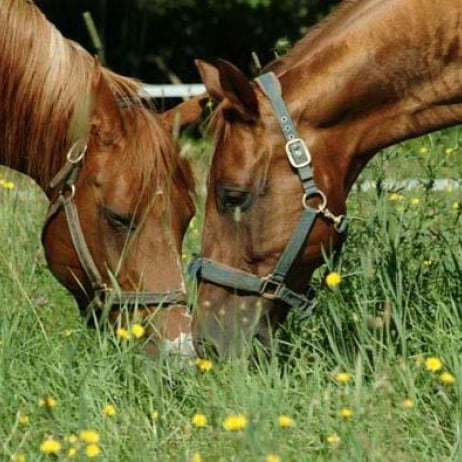
Apr 1, 2020 | Digestive health
Feeding Oils and Fats to Horses – The Natural Suppliers of Omega 3 and 6
Feeding oils and fats to horses is commonplace in today’s modern nutritional practices. As a herbivore, horses are adapted to a diet naturally higher proportionally in Omega 3 fatty acids (ALA) compared to Omega 6 (LA). Omega 3 and 6 are known as the Essential Fatty Acids, meaning the horse cannot manufacture them for itself.
The horse’s natural supply of essential fatty acids usually comes from fresh grass. Although low in total fat (2-4%) a significant proportion of that fat (39-56%) is alpha-linoleic acid (ALA) compared to Linoleic Acid (LA.) The ratio is approx 4:1 ratio of ALA to LA. Once grass is cut and dried to produce hay however, the naturally occurring unsaturated fatty acids are destroyed by oxygen. So, if hay is the main forage source for your horse, you need to add those EFA’s to the diet.
Supplementing with oils or fats that contain higher levels of Omega 3 than Omega 6 has proven to be beneficial to all horses. Especially those that aren’t eating fresh grass pasture for at least 18 hours per day.
Feeding Oils and Fats to horses – What’s the difference?
Oils and fats are essentially the same. It’s just that oils describe fats that are liquid at room temperature, whilst fats are solid at room temperature. There’s plenty of choice when it comes to feeding oils and fats to horses. And they can come in a number of different forms such as oils, seeds, pellets or ground ‘meals’. They’re considered slow release energy sources, which means they gradually release energy into the horse’s blood stream. This helps to reduce the risk of hyperactive behaviour. Feeding oils or fats alongside a good quality fibre can also be of considerable benefit for improving condition. This is because they have twice as many calories as carbohydrates making them very calorie dense. For example, did you know that one cup of oil provides the same amount of digestible energy as approx 0.55kg of oats?
Depending on the source, oil has Digestible Energy levels of 20-38 MJ/kg. This compares to a typical value of 8MJ/kg for hay, 12-14MJkg for super fibres and 9-11MJ/kg for cereals.
Triglycerides and omega 3, 6, and 9
Oils such as linseed, sunflower, corn and soya contain a lot of different fatty, acid-rich substances called triglycerides. Triglycerides themselves are made up of different types of fatty acids, including the omega-6 or omega-3s. They’re often referred to as poly-unsaturated fatty acids (PUFAs).
When it comes to deciding which oil you should be feeding your horse, it’s important to remember that all oils have the same amount of energy and it’s their ratio of Omega 3 and 6 which separates them.
Omega 3 and 6 EFAs play a very important role within the equine diet. They work synergistically within the horse’s body and balancing these essential fatty acids is paramount to optimal digestive health. Research has shown that the appropriate ratio would be in the region of 2-5:1 Om 3:6.
Two very important omega-3 fatty acids
These are eicosapentaenoic acid, (EPA) and docosahexaenoic (DHA). They’re the building blocks for hormones and also have an important role in the following:
- The structure and formation of the wall of red blood cells. This is essential for competition and performance horses where oxygen transportation can be improved by the structure of the red blood cells
- Essential component of soft tissue structure
- Hormone activity
- Central biochemical role
- Energy storage system
- Providing energy that by passes the anaerobic stages that are associated with muscle fatigue and “fast release” energy
- Being an excellent source of concentrated energy
- Physical insulation and protection of body organs
- Maintaining conformity and combatting excessive heat loss
- immune function and tissue repair within the horse’s body
Most oils contain Omega 9. This is a non-essential fatty acid and very little is known about the horse’s requirements. It can be synthesized by the horse from unsaturated fats. However, if Omega 3 and 6 intake is low then of course Omega 9 must also come from the diet.
Feeding Oils and Fats to Horses – The best sources of Omega 3 and 6 and Their Benefits
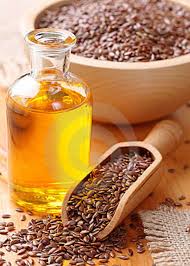
Linseed oil is almost 60% pure Omega-3 fatty acids and is one of the richest plant based sources of Omega-3. Hemp oil contains an Omega 3 fatty acid, stearidonic acid, in addition to an unusual omega-6 fatty acid, gamma-linolenic acid, which behaves like an omega-3. Chia seeds are another high Omega 3 ingredient.
BENEFITS:
- Omega-3 is a natural anti-inflammatory helping to reduce prostaglandins responsible for pain and inflammation in the horse’s body.
- Omega 3 oils have been shown to have an important role in the structure and formation of the wall of red blood cells. Essential for competition and performance horses where oxygen transportation can be improved by the structure of the red blood cells.
DEFICIENCIES:
Deficiencies in Omega 3 can lead to
- hoof problems
- allergic skin conditions.
- temperament issues
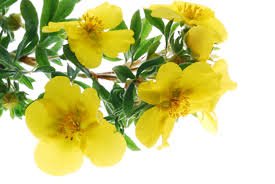
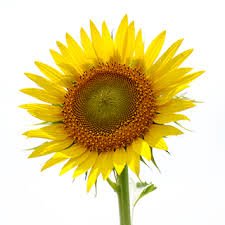 Conversely, Omega 6 is equally important to the equine diet and is most commonly found in corn, canola, rice bran, primrose, and sunflower oils. Soya oil is also a rich source of Omega-6 at almost 50% Omega-6.
Conversely, Omega 6 is equally important to the equine diet and is most commonly found in corn, canola, rice bran, primrose, and sunflower oils. Soya oil is also a rich source of Omega-6 at almost 50% Omega-6.
BENEFITS:
Omega 6 is a natural pro-inflammatory and is essential for immune function and tissue repair within the horse’s body.
EXCESS:
Too much Omega 6 can have adverse implications on your horse’s health for example:
- inflammation in joints and muscles. The ageing joints of older horses are more painful when omega 6 is fed in large amounts.
- tissue damage from oxidative stress caused by inflammation.
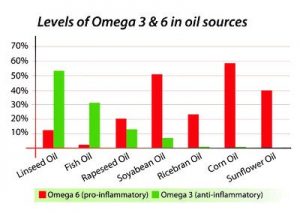
The table left, shows some of the commonly fed oils and their proportion of Omega 3 and 6.
How much should I Feed?
This will depend on your feeding goals. It may take only half a cup of oil a day to add shine to a horse’s coat. However, if you’re adding oil for performance benefits then 1-2 cups of oils for a 500kg horse may be needed. Any supplemental oil should always be added gradually to the horse’s feed to avoid digestive problems. Remember also that when feeding oil, additional vitamin E at a rate of 1IU of vitamin E per 1ml of oil may be required to help prevent peroxidative damage. Some oils may already include this, likewise fat pellets may already have vitamin E included for this purpose.
As with any other nutritional rule, moderation is the key. A daily intake of 2-5% of feed as oil is sufficient for most situations. It can be increased slightly for the onset of winter, or where a moderate to heavy level of activity is anticipated.
Supplementing your Horse with Oils and Fats – Can I feed too much?
Yes. As with any nutrient it’s possible to feed too much. When feeding fats and oils to horses, there are some important considerations to make:
- Be attentive to nutrient imbalances when top-dressing oil onto an existing ration. Eg high levels of fat in the diet may mean a higher need for antioxidants such as vitamin E
- Remember that higher rates of fat inclusion may increase the risk of digestive disturbances.
- Higher rates of fates may reduce calcium absorption via formation of mineral-fat soaps.
- Palatability may also be another factor to consider with some horses disliking oils but accepting it in a ‘meal’ form.
- Be mindful that ponies, donkeys, mules and minis are unable to tolerate high levels of fats.
- Fats shouldn’t be fed to horses that are already overweight/obese, or those prone to hyperlipemia.
- Avoid fats as part of an initial re-feeding programme for starved or severely malnourished horses. Many of these horses will have compromised gastrointestinal and organ function and will have a poor tolerance to digest them.
What’s a good alternative to oil?
Cereals and Fibres
You could fulfill the majority of energy requirements using a combination of cereal and fibre, especially super fibres. But not all horses need or can tolerate cereal feeds. Having said that, it’s actually impossible to feed a diet without fat, as it’s found in most feed stuffs albeit often as a seed meal. In this case small supplements of oil are all that are needed.
A High Quality Feed Balancer Supplement
Feeding a Fibregenix balancer with the correct, balanced level of Omega 3 and 6 fatty acids is a great way to ensure a nutritionally balanced diet. It can take approximately 30 – 90 days until the benefits of feeding these essential fatty acids can be seen. But once your horse’s diet has the optimum levels of Omega 3 and 6, you’ll notice improved overall health and well-being.
Copra – A viable Alternative?
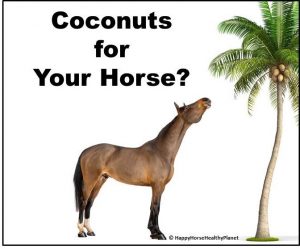 Coconut oil, or more often coconut meal (copra), is commonly added to horses’ diets to promote condition. It’s a saturated fat with virtually no Omega 6 and crucially contains zero omega 3s. Therefore, if you feed this as your only source of fat and your horse has no access to grazing, your horse will become Omega 3 deficient. Coconut oil and copra are more than 90% saturated fatty acids consisting of over 60% medium chain triglycerides which don’t exist in grasses. One therefore has to query the value of feeding a saturated fat which a horse doesn’t usually get in his diet…
Coconut oil, or more often coconut meal (copra), is commonly added to horses’ diets to promote condition. It’s a saturated fat with virtually no Omega 6 and crucially contains zero omega 3s. Therefore, if you feed this as your only source of fat and your horse has no access to grazing, your horse will become Omega 3 deficient. Coconut oil and copra are more than 90% saturated fatty acids consisting of over 60% medium chain triglycerides which don’t exist in grasses. One therefore has to query the value of feeding a saturated fat which a horse doesn’t usually get in his diet…
Fish Oils
Whilst rich in the long chain Omega 3 fatty acids, EPA and DHA, fish oils are higher in LA than ALA and can be contaminated with heavy metals such as copper or mercury and organic pollutants such as PCBs or dioxins. This poses the question as to whether it’s worth the potential risk. Palatability can also be an issue for some horses. After all, a horse doesn’t normally eat fish!
Summary
Horses are very well adapted to utilising oils and fats in their diet, particularly as a source of energy. Always try and follow a horse’s natural herbivorous diet and choose your oil/fat accordingly.
Reviewed and amended Feb 2022


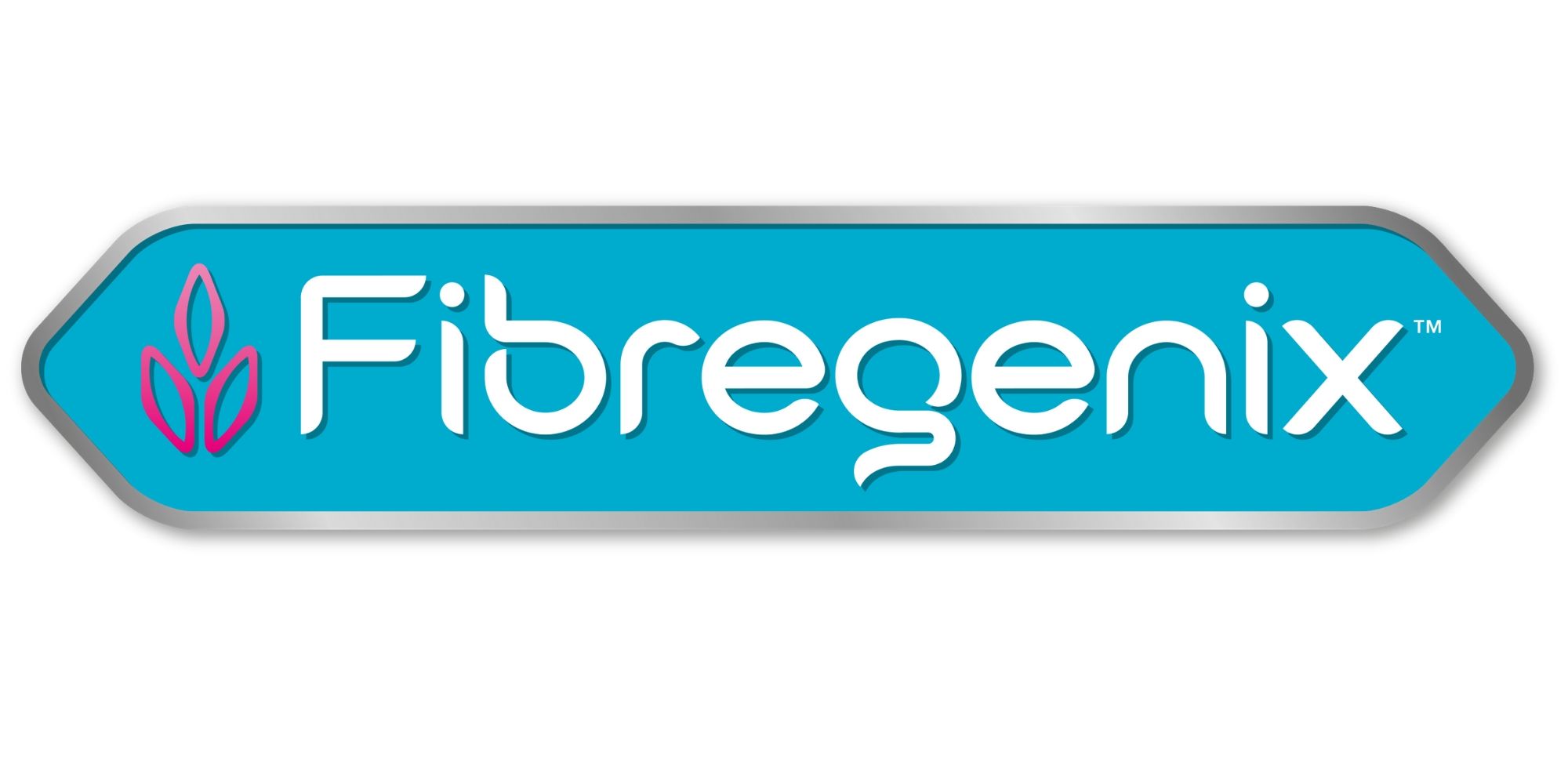



 Look at the Digestible Energy (DE) per kg of the fibre. It’s quite low, so it can’t provide too much energy per gram of dry matter. This would correspond with the volume at which you would feed it. After all, fibre should be making up the largest proportion of the diet. However, look at the conditioning mix. Whilst fed in much smaller quantities, it has a much higher DE per kg. Therefore feeding too much of a high DE feed in the incorrect quantity could affect your horse’s weight and condition!
Look at the Digestible Energy (DE) per kg of the fibre. It’s quite low, so it can’t provide too much energy per gram of dry matter. This would correspond with the volume at which you would feed it. After all, fibre should be making up the largest proportion of the diet. However, look at the conditioning mix. Whilst fed in much smaller quantities, it has a much higher DE per kg. Therefore feeding too much of a high DE feed in the incorrect quantity could affect your horse’s weight and condition!



 Conversely, Omega 6 is equally important to the equine diet and is most commonly found in corn, canola, rice bran, primrose, and sunflower oils. Soya oil is also a rich source of Omega-6 at almost 50% Omega-6.
Conversely, Omega 6 is equally important to the equine diet and is most commonly found in corn, canola, rice bran, primrose, and sunflower oils. Soya oil is also a rich source of Omega-6 at almost 50% Omega-6.
 Coconut oil, or more often coconut meal (copra), is commonly added to horses’ diets to promote condition. It’s a saturated fat with virtually no Omega 6 and crucially contains zero omega 3s. Therefore, if you feed this as your only source of fat and your horse has no access to grazing, your horse will become Omega 3 deficient. Coconut oil and copra are more than 90% saturated fatty acids consisting of over 60% medium chain triglycerides which don’t exist in grasses. One therefore has to query the value of feeding a saturated fat which a horse doesn’t usually get in his diet…
Coconut oil, or more often coconut meal (copra), is commonly added to horses’ diets to promote condition. It’s a saturated fat with virtually no Omega 6 and crucially contains zero omega 3s. Therefore, if you feed this as your only source of fat and your horse has no access to grazing, your horse will become Omega 3 deficient. Coconut oil and copra are more than 90% saturated fatty acids consisting of over 60% medium chain triglycerides which don’t exist in grasses. One therefore has to query the value of feeding a saturated fat which a horse doesn’t usually get in his diet…